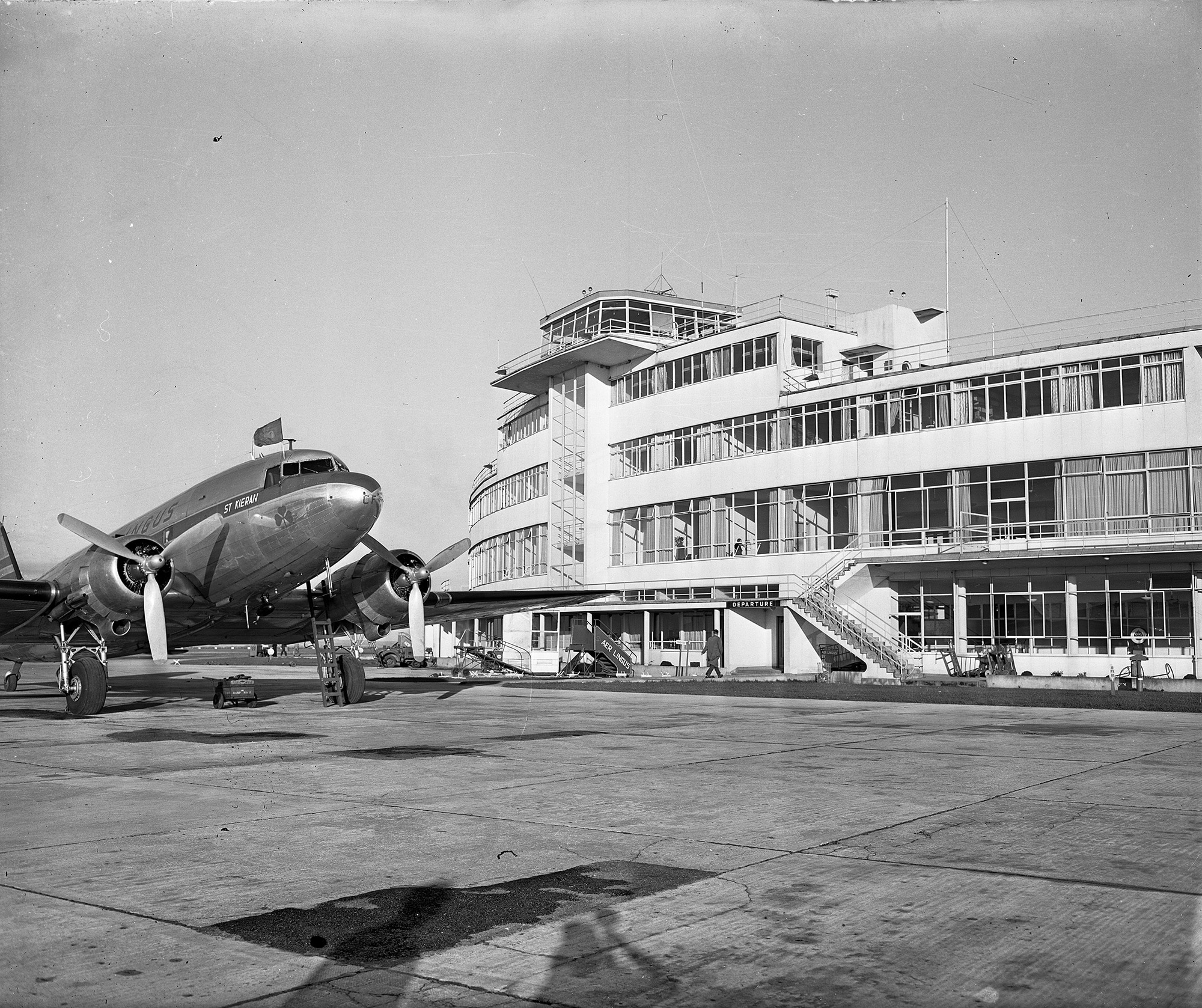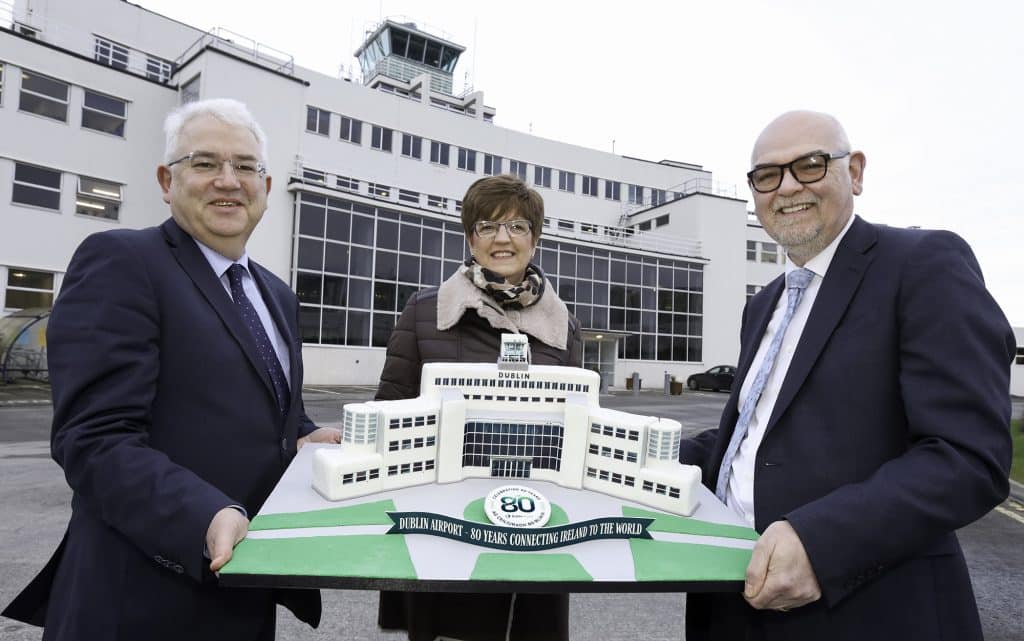
Dublin Airport celebrated its 80th birthday on Sunday 19 January 2020. About 580 million passengers have been welcomed at Dublin Airport since the first commercial flight, an Aer Lingus Lockheed 14 aircraft, departed for Liverpool’s Speke Airport at 9.00am on Friday 19 January 1940.
Airport operations commenced with just a single flight on its opening day. Dublin Airport is now an international gateway for the island of Ireland, a significant hub for transatlantic traffic and in the top tier of European airports. In 2018, it welcomed 31.5 million passengers and it has more than 233,000 take offs and landings per year.
To mark the birthday, Dublin Airport had musical entertainment between 10.30 and 12.30 from the Bugle Babes in Terminal 1 and The Apple Blossoms in Terminal 2, while the Dublin Airport Police and Fire Service Band played in Terminal 1 between 14.00 and 16.00.
Dublin Airport has come a long way in those 80 years, according to Dublin Airport Managing Director Vincent Harrison. “From one flight twice-weekly to one destination in 1940 to 700 flights daily, with direct services to more than 190 destinations in 42 countries, Dublin Airport is a thriving hub of economic activity, a significant employer and contributor to the exchequer.”
Dublin Airport’s award-winning original terminal building was designed to handle up to 100,000 passengers per year. Last summer, Dublin Airport welcomed more than 100,000 passengers every day.

“While the scale of Dublin Airport has changed dramatically over the past 80 years, the core of what the airport does has remained exactly the same throughout that period,” added Vincent. “Dublin Airport connects Ireland to the world, and we bring people together – for business, for pleasure, at times of sadness, and at times of joy.”
Dublin Airport also plays a vital role in growing inbound tourism, in boosting Irish trade and exports and in facilitating foreign direct investment in the Irish economy. “Dublin Airport is at the heart of the Irish economy and its impact reaches all 32 counties on the island of Ireland.”
He said that Dublin Airport’s employees are a fundamental element in the success of the airport. “Dublin Airport is a hive of activity 364 days per year and it simply couldn’t operate without the dedication of tens of thousands of employees from daa, airlines, ground handlers, air traffic control, state agencies, retail concessionaires and other firms. As Dublin Airport celebrates its 80th birthday, I would like to thank current staff and their retired colleagues.”
Dublin Airport was originally known as Collinstown Airport, as it was located in the townland of Collinstown, north of Dublin city centre. Collinstown had been used as a British Royal Flying Corps and RAF base between 1917 and 1922 but had fallen into disrepair before being selected as the site for the new Dublin Airport in late 1936.
Work began on the airport site in 1937, as more land was acquired, and site clearance commenced for the new grass runways. Construction of the new terminal building started in the summer of 1938.
The architect of the terminal was Desmond FitzGerald, an elder brother of former Taoiseach, Dr Garret FitzGerald, who led a team of young architects. The curved building and its tiered structure, which echoed the lines of a great ocean liner, won many architectural awards for its design.
Collinstown Airport remained relatively quiet during the 1940s, as war raged throughout Europe. However, Aer Lingus continued to operate a twice-weekly service to Liverpool. During this period, Dublin Airport was required to observe black-outs and anti-aircraft guns were in place for defensive purposes.
By 1947, flights departing from Dublin ventured as far as Europe with Dutch airline KLM beginning the first continental service to Dublin. New concrete runways were completed in 1948, and in 1950, after 10 years in operation, the airport had been used by a total of 920,000 passengers.
Air travel was the preserve of the wealthy during this period and many Dubliners would have travelled to the airport simply as a treat to see the aircraft. The terminal building also had one of Dublin’s best restaurants, the Collar of Gold, which was hugely popular and not only for those travelling.
As Dublin Airport’s route network grew and its passenger numbers expanded, it became clear that the original terminal building had far exceeded its capacity.
The North Terminal opened in 1959 and was used to process arriving passengers, while the old terminal remained in place for departing passengers.
By 1963, Dublin Airport had grown to one million passengers per year and additional facilities were again required. New boarding gate areas were added in the 1960s and work on a new terminal building began in 1969. The new terminal building, now known as Terminal 1, opened in 1972 and was originally designed to cater for six million passengers per year.
In November 1985, the Government approved the construction of a new runway at Dublin Airport, together with new taxiways, and a new air traffic control building. The new runway 10/28 officially opened for flights on 21 June 1989. That year, more than five million passengers used Dublin Airport.
Passenger numbers increased to 5.8 million in 1992 and following 17 consecutive years of growth, reached 23.5 million in 2008.
Facilities, however, had not kept pace with the passenger growth and between 2007 and 2010 Dublin Airport embarked on a major investment programme to transform the airport by significantly increasing capacity and dramatically improving the passenger experience.
This programme delivered Terminal 2, two new boarding gate areas (the 100 gates and the 400 gates), a new road network, and a host of other major improvements. The new award-winning new terminal was opened in November 2010.
The economic downturn saw passenger numbers decline to 18.4 million in 2010, before eight consecutive years of growth boosted them to 31.5 million by 2018.
Dublin Airport has hosted many dignitaries and special homecomings during its 80-year history. It has welcomed seven US Presidents, two Popes, the return of many Irish Olympic medal winners, a host of Eurovision winners, the Irish football team returning from World Cups and European Championships, and the Irish rugby team with the Grand Slam trophy.
This summer Dublin Airport will have 13 new routes and services including two new long-haul destinations, with Juneyao Airlines launching a twice-weekly service to Shanghai via Helsinki and United Airlines operating a new year-round daily service to San Francisco.
Dublin Airport’s short-haul network is also expanding, with 11 new summer services to the following destinations: Brindisi and Verona in Italy, Marseille and Toulouse in France, Alghero in Sardinia, Tel Aviv in Israel, Billund in Denmark, Podgorica in Montenegro, the Balearic Island of Menorca, Palanga in Lithuania, and the Egyptian capital Cairo.
Dublin Airport will be posting 80th birthday related content on its award-winning social media channels using the hashtag #DUB80 throughout the year.
Dublin Airport: How Time Flies
1936 Irish Government announces plans for a civilian airport at Collinstown
1938 Work begins on the new terminal building
1940 Dublin Airport opens on 19 January 1940 with a flight per day to Liverpool Speke Airport
1945 First Dublin Airport-London service begins to Croydon Airport
1947 KLM starts Dublin-Manchester-Amsterdam service
1948 Completion of concrete runways
1949 Passenger numbers reach 200,000 per year
1958 First scheduled transatlantic service as passenger numbers top 500,000 per year
1959 North Terminal opens
1963 Passenger numbers top 1 million for the first time
1972 Terminal 1 opens
1989 Passenger numbers reach 5 million
1990 Celebrates 50th birthday
1997 Welcomes more than 10 million passengers
2008 Passenger numbers reach a record 23.5 million
2010 Terminal 2 opens
2014 Welcomes 21.7 million passengers
2015 Celebrates 75th anniversary
2016 Passenger numbers pass 30 million for the first time
2016 Plans announced to proceed with a new North Runway
2019 First sod is turned on the new runway site
2020 Dublin Airport celebrates 80th anniversary




